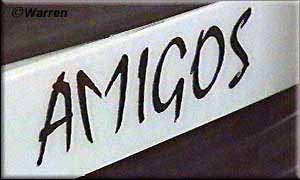Number Plates and the Law.
DVLA guidelines on how they
should be displayed.
All registration marks including marks purchased through DVLA's
sales scheme must be displayed in accordance with The Road Vehicles
(Display of Registration Marks) Regulations 2001 (obtainable
from Her Majesty's Stationery Office).
Rules for the display of number plates are set out in law,
briefly these are: -
NUMBER PLATES FITTED AFTER 1 SEPTEMBER 2001
Number plates fitted after 1 September 2001 must display characters
that meet the dimensions shown below.
| Characters |
|
| Height |
79mm |
| Width (except the figure 1 or letter l) |
50mm |
| Stroke |
14mm |
| Space between characters |
11mm |
| Space between groups |
33mm |
| Top, bottom and side margins (minimum) |
11mm |
| Space between vertical lines |
19mm |
The character width has been slightly reduced
from 57mm to 50mm to accommodate the Euro-symbol on the number
plate.
Number plates fitted before 1 September 2001
must display characters that meet the dimensions shown in one
of the two groups below
| Characters |
Group 1 |
Group 2 |
| Height |
89mm |
79mm |
| Width (except the figure 1or letter
l) |
64mm |
57mm |
| Stroke |
16mm |
14mm |
| Space between characters |
13mm |
11mm |
| Space between groups |
38mm |
33mm |
| Side margins (minimum) |
13mm |
11mm |
| Space between vertical lines |
19mm |
19mm |
- Vehicles constructed before 1.1.73 may display traditional
style "black and white" plates i.e. white, silver
or grey characters on a black plate.
- Lettering must be of a set size. It must conform to one
of the two groups below.
| Characters |
Group 1 |
Group 2 |
| Height |
89mm |
79mm |
| Width (except the number 1) |
64mm |
57mm |
| Stroke |
16mm |
14mm |
| Side margin |
25mm |
11mm |
| Top & bottom margin |
13mm |
11mm |
| Space between characters |
13mm |
11mm |
| Space between groups |
38mm |
33mm |
Display of Vehicle Registration Marks on Imported Vehicles
(which have a restricted space for a standard sized number plate)
Certain imported vehicles may be permitted to display number
plates with smaller characters if:
Specifications for smaller sized plates (for
certain imported vehicles)
| Character Height |
|
64mm |
| Character Width |
|
44mm |
| Character Stroke |
|
10mm |
| Space between characters |
|
10mm |
- Motorcycles and tricycles registered after 1.9.2001 must
only display a number plate at the rear of the vehicle.
- Motorcycles and tricycles registered before 1.9.2001 can
display a number plate at the front but are not required to.
- The characters may be smaller e.g.
| Character Height |
|
64mm |
| Character Width |
|
44mm |
| Character Stroke |
|
10mm |
| Space between characters |
|
10mm |
| Space between groups |
|
30mm |
| Top, side & bottom margin |
|
11mm |
| Space between vertical lines |
|
13mm |
- Motorcycles registered on or after 1 September 2001 must
display a two-line number plate number plate. Motorcycles
registered prior to the 1 September 2001 may display a three-line
plate, but one-line plates are illegal, irrespective of the
date of registration of the motorcycle.
MANDATORY CHARACTER FONT
From 1 September 2001 all new number plates must display the
new mandatory font. Combined with the new format registration
mark, number plates will become clearer and easier to remember.
Number plates fitted before 1 September 2001 need
not be changed provided the character font used is substantially
the same as the one shown above.
Number plates must be replaced if they have been customised
with:
- Stylised letters and/or figures such as italics
- Number plate fixing bolts that alter the appearance of the
letters and/or numbers
THE EURO PLATE

Since 1st September 2001 there has been an optional provision
for the display of a Euro-plate for vehicles registered in the
UK. The Euro-plate is a number plate that incorporates the symbol
of the European Union (a circle of 12 stars on a blue background)
with the national identification letters of the member states
below. This symbol is located on the far left-hand side of the
number plate.
Vehicles displaying this symbol no longer have to use the traditional
oval shaped national identifier (GB) sticker when travelling
within the European Union. All vehicles registered in England,
Northern Ireland, Scotland and Wales have, by international
convention, the distinguishing sign GB.
The Government announced on 28 December 2001 the intention
to permit the display of national flags and national identifiers
on vehicle number plates. The Road Vehicles (Display of Registration
Marks) Regulations 2001 are in the process of being amended.
They will provide for the voluntary display of the Union flag,
Scottish Saltire, Cross of St George and Red Dragon. Football
team crests etc are not allowed.
THE LAW
The law states that, You must not alter, rearrange or misrepresent
the letters or numbers
- Characters must not be moved from one group to the other
(e.g. A242 ABC must not be displayed as A242A BC).
- Offences may result in any or all of the following:
Characters must not be moved from one group to the other (e.g.
A242 ABC must not be displayed as A242A BC).
Offences may result in any or all of the following:
A fine of up to £1,000
- The registration mark may be WITHDRAWN .
- The vehicle may FAIL the MOT test
Full details of the requirements are included in The Road
Vehicles (Display of Registration Marks) Regulations 2001
The British Standard sets out the physical characteristics
on the number plate. This includes:
- Visibility
- Strength
- Reflectivity
The British Standard also requires that a number plate must
be marked with the following information: -
- The British Standard Number (currently BS AU 145d)
- The name, trade mark, or other means of identification of
the manufacturer or component supplier. (The company who actually
make the number plate.)
- The name and postcode of the supplying outlet. (The 'supplying
outlet' is taken to mean a company whose business consists
wholly or partly of selling number plates.)
- A non-reflective border and the Euro-symbol with the national
identification letters are optional additions.
- There shall be no other markings or material contained on
the number plate.
A New Format from September
2001
From 1 September 2001, number plates will take on a new format.
The present age identifier prefix letters run out next year. Vehicles
registered as new from 1 September 2001 will have number plates
that include
- a two letter regional identifier
- a two figure age identifier
- three random letters
The new format will make number plates
easier to read and make them more memorable.
A New Font Style
From 1 March 2001, a new number plate font style is to be introduced.
This will make it illegal for any vehicle being used on the public
highway to have a number plate which does not conform to the new
style. Motorists whose vehicles bear number plates which have
been customised by means of stylised letters and figures such
as italics or the placement of number plate fixing bolts must
replace them or risk prosecution.
The new mandatory font style is
based on the 'Charles Wright' font as shown below:
The overall width of characters will
be reduced from 57mm to 50mm.
GB Euro symbol
From 1 March 2001, motorists may if they wish, incorporate the
GB Euro symbol onto their number plates. The display of national
emblems on number plates will be prohibited. If desired they may
be displayed, as now, on other parts of the vehicle.
The DVLA plans
to work with the Association of Chief Police Officers (ACPO) to
crackdown on drivers.

Many drivers alter the spacing and typefaces on number plates
to spell names and messages. But some plates can make registration
numbers unreadable by speed cameras.
Drivers who tamper with car number
plates are likely to face prosecution in a new clampdown.
It is already an offence to make
letters look like numbers and vice versa, but the Driver Vehicle
Licensing Agency (DVLA) in Swansea has said it intends to crack
down.
Thousands of personalised registration
numbers are allowed - the DVLA sells assignment rights to attractive
numbers and many people are prepared to pay high sums for novelty
numbers.
But the problem is when people change
the letter spacing and make the plate hard to read. Cars with
these plates fail MOT tests and there is a maximum £1,000 fine.
Police concerns
A simple change in letter spacing
can make 13 look like B or 8. The letter O can look like D, 12
can look like 15 and the letter S can get confused with the number
5.
Police are concerned that vehicles
involved in hit and run accidents can be difficult to trace.
The DVLA plans to work with the
Association of Chief Police Officers (ACPO) to crackdown on drivers. From 1 March people without correctly displayed plates may
have their registration marks withdrawn permanently without compensation. |




